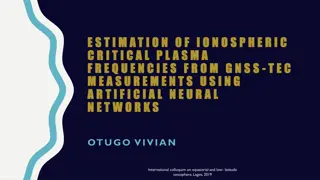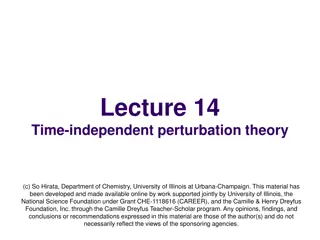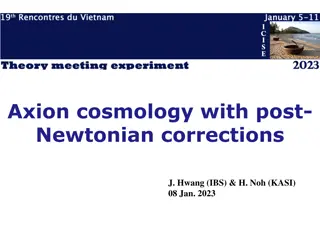Four-Year Plan for WMO Space Weather Activities 2024-2027
Space Weather is a crucial aspect of the natural space environment affecting various technologies on Earth and in space. The plan outlines goals, historical context, and key recommendations by INFCOM-3 for monitoring and modeling solar, magnetospheric, and ionospheric activities. Integration of Spac
0 views • 9 slides
Earth-GRAM Overview and Updates 2023
Earth-GRAM is a global reference atmospheric model providing monthly mean and standard deviation data for various atmospheric variables. It is used in engineering for dispersion simulations but is not a forecasting model. Updates to Earth-GRAM include the Modern Era Retrospective Analysis, a global
1 views • 19 slides
Interactive Tutorial on Degenerate Perturbation Theory: QuILT Development and Student Difficulties
Developing an interactive tutorial on Degenerate Perturbation Theory (DPT) to aid students in understanding the challenging synthesis of Quantum Mechanics concepts with Linear Algebra. The tutorial focuses on addressing common student difficulties, such as identifying good bases, diagonalizing matri
0 views • 12 slides
Optimum Solar Proxy for Long-Term Ionospheric Studies
The search for the best solar proxy for long-term ionospheric studies is ongoing due to the lack of consistent solar radiation data. Various solar proxies have been analyzed, and the use of Mg II for foF2 and F10.7 for foE has shown promising results, describing a high percentage of variance in the
1 views • 10 slides
Estimation of Ionospheric Critical Plasma Frequencies Using GNSS Measurements
This research focuses on estimating the critical plasma frequency of the ionosphere, specifically the F2 layer (f0F2), using GNSS measurements. The study reviews past work on ionospheric modeling, discusses neural network training inputs, and presents a single station neural network model (NNT2F2).
0 views • 26 slides
Cutting-edge Technology at Sodankyl Geophysical Observatory
The Sodankyl Geophysical Observatory in Finland utilizes state-of-the-art technology for ionospheric research, including the Alpha-Wolf sounder, a sophisticated transmitter, and receiver array. The observatory has a rich history of ionosonde operations since 1957, with continuous advancements in dat
2 views • 23 slides
Time-Independent Perturbation Theory in Quantum Mechanics
Perturbation theory is a powerful tool in solving complex physical and mathematical problems approximately by adjusting solutions from a related problem with known solutions. This theory allows for more accurate approximate solutions by treating the difference as a small perturbation. An example inv
0 views • 19 slides
Investigating Chaos Seeding in Perturbation Experiments
This research project conducted at Texas Tech University delves into the effects of chaos seeding within perturbation experiments on atmospheric conditions, with a focus on local and nonlocal modifications resulting from factors such as irrigation, wind farms, and urban development. By analyzing tin
0 views • 24 slides
COTEKINO Priority Project Summary
COTEKINO Priority Project involved developing and testing perturbation methodologies for convection-permitting ensembles across various operational weather services. Tasks included deriving perturbations, testing models, and coordinating with different agencies. The project aimed to enhance forecast
1 views • 9 slides
Lagrangian Perturbation Theory: Applications in Cosmology
Lagrangian Perturbation Theory (LPT) offers solutions for general dark energy models and is crucial for upcoming large-scale surveys. It provides a method to displace particles at large scales efficiently. While Standard Perturbation Theory (SPT) is limited at linear order, LPT overcomes its drawbac
0 views • 14 slides
Axion Cosmology with Post-Newtonian Corrections
Exploring axion cosmology with post-Newtonian corrections, this study delves into linear density perturbations for dust, the role of axion as a cold dark matter candidate, and fully nonlinear perturbation formulations. It addresses continuity, momentum conservation, and quantum stress to identify ke
0 views • 22 slides
Atmospheric Modeling Task with Initial Conditions and Grid Setup
Create a model grid with 2D arrays for prognostic variables, set initial dry and adiabatic environmental conditions, introduce thermal and pressure perturbations, and visualize using GrADS. Define variables like velocities, perturbation temperature, and pressure fields, along with base state variabl
0 views • 27 slides
Chromaticity Compensation Options for the Ion Collider Ring
The MEIC Interaction Region faces challenges due to high beta functions causing chromatic perturbation. To address this, local compensation through Chromaticity Compensation Block (CCB) with sextupoles is proposed. Three CCB options are presented for consideration. The report explores the impact of
1 views • 17 slides
Differential Evolution: An Overview of the DE Algorithm
Differential Evolution (DE) is an Evolutionary Algorithm (EA) proposed for continuous function optimization. It uses vector differences to perturb the population, deviating from traditional crossover and mutation methods. DE involves mutation, perturbation, and various mutation schemes like DE/rand/
0 views • 20 slides
Governing Equations and Model Reduction in Continuous Stratified Models
Detailed analysis of the governing equations in a continuous stratified model with vertical mode decomposition and Sturm-Liouville problem. The density perturbation and pressure perturbation are examined to derive a reduced 3D system. The Boussinesq approximation and hydrostatic balance are applied,
0 views • 36 slides
Computational Complexity in Quantum Hamiltonians
The Bose-Hubbard model is proven to be QMA-complete, indicating the challenge in solving ground energy problems in quantum systems. Various classes of Hamiltonians, such as k-local and stoquastic, exhibit different complexities in computing ground energy. While some systems with QMA-complete ground
1 views • 40 slides
Enhancing Counterfactual Explanations for Improved Understanding
This article explores the concept of generating interpretable, diverse, and plausible counterfactual explanations within explainable AI (XAI). It highlights the challenges with current methods, introduces an instance-guided approach, and emphasizes the importance of good counterfactuals. The discuss
0 views • 22 slides
Degenerate Perturbation Theory in Quantum Mechanics
Exploring time-independent perturbation theory, specifically focusing on non-degenerate and degenerate spectra. The lecture covers approximation schemes, treatment of multi-electron atom term values, and the effects of spin-orbit interaction. Concepts include evaluating expectation values, wavefunct
0 views • 13 slides
Electron-Phonon Interactions in Iron-Based Superconductors
This discussion explores the effects of electron-phonon interactions on orbital fluctuations in iron-based superconductors. Topics covered include ab initio downfolding for electron-phonon coupled systems, evaluation methods such as Constrained Random Phase Approximation (cRPA), Constrained Density-
0 views • 12 slides
GNSS Ionospheric Study in Korea: Insights and Findings
Explore the status of GNSS ionospheric study in Korea, including details on Korea's GPS permanent network, IGS, KASI Global Data Center, TEC mapping, and ionospheric tomography. Discover how ground-based GPS data is used to study ionospheric electron densities and monitor ionospheric storms in Korea
1 views • 15 slides
Update on Ionospheric Studies Task Force (ISTF/4) Meeting in Philippines
The ISTF/4 meeting in Philippines provided updates on data collection tasks, including current and planned data sources. The report highlighted the total number of operating stations, types of data collected, and progress on new site installations. Additionally, updates on the use of data within CAA
0 views • 4 slides
Ionospheric Absorption Laws and Regions
The principles of the ionosphere at middle and low latitudes, Lambert-Beer exponential absorption law, and characteristics of E and F regions are discussed. The absorption of solar radiation, recombination reactions in different regions, and ionization processes are highlighted, providing insights i
1 views • 15 slides
Recent Insights into Mars Ionosphere Studies with MARSIS-AIS
Discover recent research on the Martian ionosphere conducted by scientists using various instruments such as MARSIS, MAVEN, and MarMCET. Explore studies on electron density profiles, ionospheric traces, and the timing issue correction of the AIS sounding cycle. Publications address improvements in a
1 views • 6 slides
Implementation of Cornell Ionospheric Scintillation Model in Spirent GNSS Simulator
Researchers from the University of Nottingham and Spirent Communications collaborated to implement the Cornell Ionospheric Scintillation Model into the Spirent GNSS Simulator. The study focuses on the diffractive effects of ionospheric scintillation on GNSS signals, examining small-scale plasma irre
0 views • 24 slides
Investigation of Low-Latitude S-Band Ionospheric Scintillations during September 2017 Geo-Magnetic Storm
The study focuses on analyzing the impact of geo-magnetic storms on NAVIC satellites, particularly the S-band signal, during September 2017. Researchers from K.L. Deemed to be University observed variations in solar and geomagnetic activity indices, providing insights into the behavior of the ionosp
0 views • 15 slides
Study on Ionospheric Perturbation Due to Solar and Geomagnetic Activity in Odessa Magnetic Anomaly
Research conducted in the area of the Odessa magnetic anomaly investigates ionospheric perturbations caused by solar and geomagnetic activity. The study utilizes radio astronomical and magnetometric observations from various observatories, highlighting the significance of the geomagnetic anomaly nea
1 views • 18 slides
Insights into Theoretical Approaches in NMR Spectroscopy
Theoretical approaches in NMR spectroscopy encompass diverse methods, each with varying degrees of approximation but yielding correct results within their validity. Techniques such as transition probabilities using the time-dependent perturbation theory, Zeeman interaction for energy level transitio
0 views • 32 slides
Comparison of MSTID and Sporadic E Distributions in Ionosphere Study
Investigating the role of sporadic E in medium-scale traveling ionospheric disturbances by comparing its distribution with MSTID using CHAMP satellite data. Sporadic E and MSTID occurrences, detection methods, and distribution patterns in different hemispheres are explored, revealing seasonal variat
0 views • 9 slides
Heuristic Approach for the Min-Max Multi-Depot Vehicle Routing Problem
This study explores a three-stage heuristic to solve the Min-Max Multi-Depot Vehicle Routing Problem (MDVRP), aiming to minimize the maximum distance traveled by vehicles. It covers an introduction to the problem, literature review, the importance of the min-max objective, and a heuristic solution m
0 views • 21 slides
Contribution of Ly in Ionization Rate and Electron Density Changes in Ionospheric D-region
Study explores how Ly radiation and solar X flares impact ionization rate and electron density in the ionospheric D-region. Research conducted by Aleksandra Nina, Vladimir ade, and Jovan Bajeti provides insights on electron density dynamics, theoretical modeling, and observations.
0 views • 15 slides
Identification of Ionospheric Earthquake Precursors in Kamchatka
Investigating ionospheric variations preceding strong earthquakes in the Kamchatka region using correlation analysis. Method based on electron concentration changes in the ionosphere. Two ionospheric stations, PK553 and EA653, located in different geographic areas are analyzed for correlation coeffi
0 views • 12 slides
Estimation of Earthquake Occurrence Probability Based on Seismological and Ionospheric Precursors
Presentation on estimating earthquake occurrence probability in the Kamchatka region using a combination of seismological and ionospheric precursors. The method involves analyzing mid-term and short-term predictive signs to determine the probability of strong earthquakes. The study discusses the sei
0 views • 11 slides
Vulnerabilities of GNSS Technology
GNSS technology, a critical aspect of modern life, faces vulnerabilities like weak signals, human interference, ionospheric disturbances, and atomic clock errors. These vulnerabilities pose threats to precise navigation and communication systems, highlighting the need for robust countermeasures to e
0 views • 22 slides
Planetary Radio Interferometry and Doppler Experiment (PRIDE) Analysis
Investigate the scintillation of radio signals from VEX and MEX in interplanetary and ionospheric plasma. Explore data processing, target missions, and spacecraft interactions through PRIDE. Analyze orbital perturbations, atmospheric drag campaigns, and gravity coefficients. Collaborate with VLBI ne
0 views • 12 slides
Understanding the Impact of Ionospheric Scintillation on Satellite Positioning
Explore the effects of ionospheric scintillation on satellite positioning and timing, leading to potential disruptions in satellite navigation systems. Learn how rapid changes in satellite radio signals can impact accuracy and reliability, with insights from cutting-edge research presented at a scie
0 views • 14 slides
Influence of Channel Model Parameters on PCM Signal Characteristics for Ionospheric HF Communications
Explore the impact of channel model parameters on PCM signal attributes for HF radio links. Tasks include signal synthesis, modeling, algorithm development, and verification. Diagnose ionospheric variability to enhance radio equipment design. Discover HF radio channel models like Watterson and Vogle
0 views • 12 slides
Processing with Track M. A. Floyd: GPS Data Analysis and Kinematic Solutions
Explore the basics of processing GPS data with Track M. A. Floyd, focusing on kinematic GPS, general aspects, slow-moving sites, and issues with length. Learn about the importance of station separation, automated solutions, ionospheric delays, and more in GPS data processing.
0 views • 33 slides
EISCAT_3D Project Challenges for UK Community Collaboration
Explore the EISCAT_3D project challenges encouraging wide participation from the UK community, focusing on ionospheric coupling research. Engage in discussions, form teams, and develop proposals to enhance community involvement and secure funding opportunities.
0 views • 5 slides
Processing with Track T. A. Herring: GPS Data Analysis Basics
Explore the basics of GPS data processing and analysis with Track T. A. Herring, covering kinematic GPS, general aspects, slow-moving sites, and issues related to site separation and ionospheric delays. Gain insights into the processing techniques for optimal results in positioning applications.
0 views • 33 slides
Understanding Time-Dependent Perturbation Theory in Quantum Mechanics
Delve into time-dependent perturbation theory in quantum mechanics through topics like general treatment to first order, sudden approximation, adiabatic approximation, and resonant phenomena. The lecture explores the treatment of time-dependent perturbations using complete basis sets and perturbatio
0 views • 12 slides







































